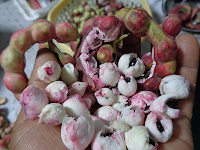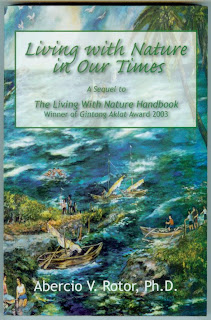Christmas Stories, Events, Jokes and Quotes
- What do you call a kid who doesn't believe in Santa? A rebel without a Claus.
- What is the popular Christmas carol in Desert? Camel ye Faithful.
- What part of the body do you only see during Christmas? Mistletoe.
- What do you call people who are afraid of Santa Claus? Claustrophobic.
Selected and compiled by Dr Abe V Rotor
Living with Nature School on Blog
The small girl had spent the morning watching her mother do her Christmas shopping. Finally, she found herself in a big chair beside the department-store Santa Claus, tell him her wishes. "... and a big doll and a doll buggy and a doll house ..." she finished the long list. Then sliding from the chair and walking away, she suddenly turned back a pace, and called, "And charge it, Santa Claus!"
x x x x
CONDUCTOR: "You know darn well the distance between Chicago and Cleveland is the same as from Cleveland to Chicago. Any damn foo knows that."
PASSENGER: "I dunno; it is just a week from Christmas to New Year, but is it a week from New Year the Christmas?"
x x x x
A youngster walked into a bank the other day to open an account with $000. The bank's vice president gave him a benign smile and asked how he had accumulated so much money.
"Selling Christmas card," said the lad.
"Well, you've done very well. Sold them to lots of people, obviously."
"Nope," answered the little boy proudly. "I sold all of them to one large family - their dog bit me."
x x x x
A mother took her five year old son to a mall to say, "Hello" to Santa Claus, who in turn, asked. "What would you like for Christmas, sonny?"
"A bicycle, a football, and a pair of skates." the youngster replied promptly.
"I'll certainly try to see that you get them," said Santa.
Later, the mother and son visited another mall and stopped to see Santa there. Again the same question and the same answer, but Santa asked, "And are you going to be a good boy?"
The boy turned to his mother and said, "Let's go back to the first mall; I didn't have to many any promises there."
x x x x
The alert boy of the household much wanted a watch for Christmas. The family has the custom of repeating Scripture memory verses at the breakfast, and by way of keeping them all reminded, he made frequent use of the verse: "What I say unto you I say unto all: watch."
x x x x
If you want to be reminded of Christmas all year, buy your Christmas gifts on monthly payment plan.
.jpg) x x x x
x x x x May the forgiving spirit of Him to whom we dedicate this season prevail again on earth.
May hateful persecution and wanton aggression cease.
May man live in freedom and security, worshiping as he sees fit, loving his fellow man.
May peace, everlasting peace, reign supreme.
10 Unusual Historical Events That Happened During Christmas
- Christmas Day, 1990, The Internet Gets Its First Test Run
- Washington Crosses the Delaware River in 1776
- WWI Christmas Truce Soccer Games
- USSR Invades Afghanistan in 1979
- Isaac Newton Was Born on Christmas Day
- Charlie Chaplin Passes Away
- Apollo 8 Reaches the Moon’s Orbit
- Mikhail Gorbachev Resigns as Soviet President
- The Song ‘Silent Night’ Is First Performed in Public
- President Andrew Johnson Pardons All Confederate Soldiers
----------------------------------------
The deadliest Tsunami in recorded history occured a day after Christmas killing instantly 150,000 people.The tsunami was generated by a 9.0 earthquake with epicenter at the Indian Ocean floor. The movement of the earth's crust did not only cause an earthquake with a magnitude of 9.0, but the displaced water caused a series of giant waves called tsunami.
-----------------------------------------
References" JM Braude, Speaker's Encyclopedia of Humor; Prochnow HY and HV Prochnow Jr, Jokes, Quotes and One-liners for Public Speakers; Wikipedia;
* Lesson on former Paaralang Bayan sa Himpapawid (People's School-on-Air) Dr Abe V Rotor and Ms Melly C Tenorio 738 DZRB AM Band, 8 to 9 evening class Monday to Friday












.jpg)
.jpg)












0022.JPG)




























